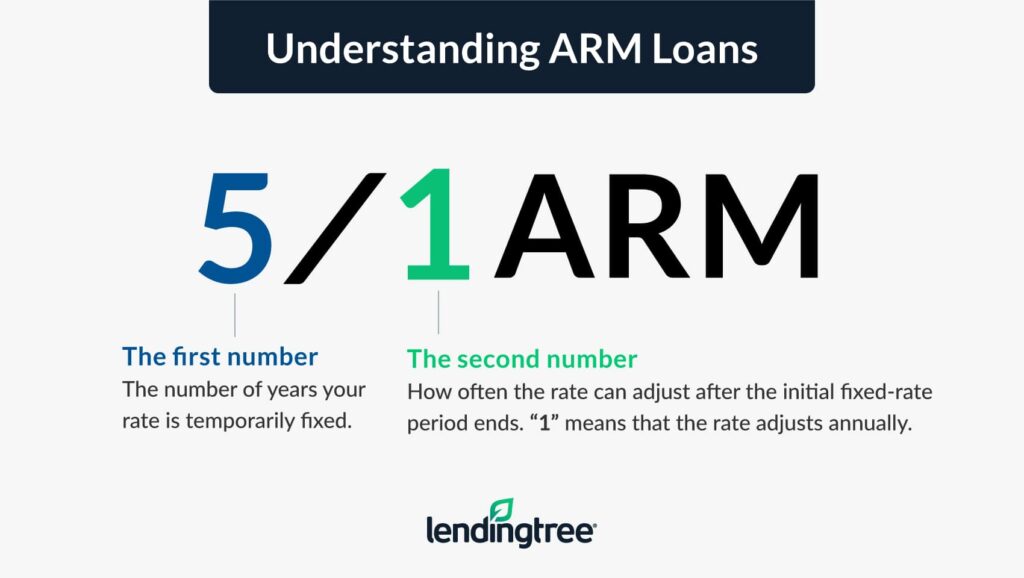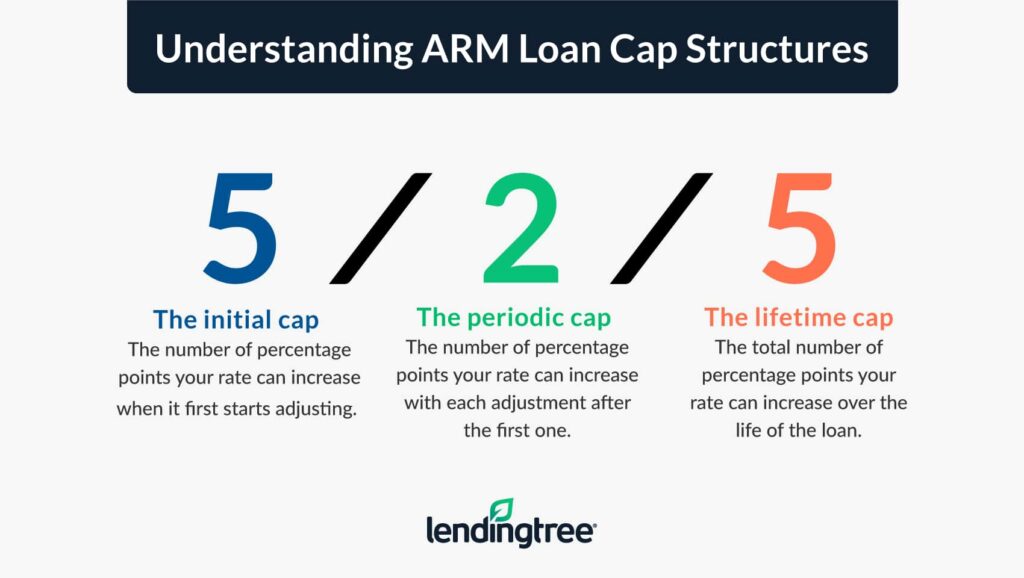5/1 ARM Loans: What You Should Know
A 5/1 adjustable-rate mortgage (ARM) loan may be worth considering if you’re looking for a low monthly payment and don’t plan to stay in your home long. Rates on 5/1 ARMs are typically lower than 30-year fixed-rate mortgages for those first five years. Understanding how the rate resets after the initial low-rate period ends will help you decide whether the temporarily lower payment is worth it.
On this page
What is a 5/1 ARM loan?
A 5/1 ARM is a type of adjustable-rate mortgage that has a fixed rate for the first five years of repaying the loan. After that period, 5/1 ARM rates change based on your loan terms. A 5/1 ARM may also be called a “hybrid mortgage” because it starts off with a temporary fixed interest rate then turns into a loan with a variable rate.
The “5” in the name of a 5/1 ARM is the number of years your rate is temporarily fixed. The “1” is how often the rate can adjust after the initial fixed-rate period ends — in this case, the “1” represents one year, so the rate adjusts annually.

How does a 5/1 ARM work?
During the initial fixed-rate period, the rate is typically lower. That low rate is also called your “introductory rate.” After that, the rate can change based on six factors:
- The initial adjustment cap. Once the fixed rate expires, the initial adjustment cap limits how much the interest rate can rise. The initial adjustment cap is generally 2% or 5%, meaning the new rate can’t rise by more than 2 or 5 percentage points.
- The adjustment period. Rate changes to an ARM loan are based on the adjustment period. For example, a 5/1 ARM will adjust every year after the five-year teaser-rate period ends. Lenders may offer adjustment periods ranging from monthly to every five years.
- The periodic cap. This is a cap on the number of percentage points your rate can increase with each adjustment after the first one.
- The index. An index is a benchmark variable rate that fluctuates based on market and economic conditions. The margin is added to your index to determine your rate with each adjustment period, and lenders should provide information to illustrate how the chosen index has changed over time.
- The margin. A margin is a fixed number set by the lender and added to the index to determine your rate when it adjusts.
- The lifetime cap. Many ARMs have a 5% lifetime cap, which means your rate can never be more than 5 percentage points higher than the initial rate.
Interest-only ARMs: What are they and how do they work?
Some 5/1 ARM programs may come with an interest-only option, which allows qualified borrowers to pay only the interest due on the loan for a set time, ranging between three and 10 years. This may be a good choice for borrowers trying to save as much money as possible on their monthly payment for a certain period. However, the loan balance isn’t paid down at all, which could result in a big payment jump if the loan isn’t paid off when the interest-only period expires.
When a 5/1 ARM’s interest rate adjusts
To understand when a 5/1 ARM adjusts, you need to understand how each “cap” is disclosed. When you read about ARMs, you might see their caps listed as a combination of three numbers. For instance, an ARM with “a 2/1/5 cap” means the following:
- The first number is the initial cap: Your rate can increase by no more than 2 percentage points when it first starts adjusting.
- The second number is the periodic cap: Your rate can increase by 1 percentage point with each adjustment after the first one.
- The third number is the lifetime cap: Your rate can adjust up to 5 percentage points above the initial rate over the life of the loan.

What index is used with a 5/1 ARM?
The index is important to understand because it’s the “moving” part of your adjustable rate and fluctuates with changes in the market. Your lender decides which index will be used. Most current ARM programs use the Cost of Funds Index (COFI) or the one-year Constant Maturity Treasury (CMT) securities index.
You may hear the term “fully indexed,” which simply refers to how much your rate will be when your margin and index are added together. To find out what your fully indexed rate would be, you simply add the current index rate to your margin. For example, if the CMT index rate is currently 2%, and your margin is 5%, then your fully indexed rate would be 7%.
5/1 ARM loan payment example
When you apply for an ARM, you’ll receive a 13-page Consumer Handbook on Adjustable-Rate Mortgages (CHARM) disclosure booklet and a loan estimate that details how much your rate and payment can change over time. The booklet can help you better understand the loan you’ve applied for, but as a supplementary example, here’s how a 5/1 ARM with 2/2/5 caps could adjust if you’re borrowing $300,000 with an initial 6.75% rate.
| ARM adjustment period | Interest rate | Monthly payment (principal and interest) | Description |
|---|---|---|---|
| Initial five-year fixed rate | 6.75% | $1,945.79 | Your monthly payment for the first five years |
| First adjustment cap (2 percentage points above the start rate) | 8.75% | $2,360.10 | The highest your monthly payment could be the first time it adjusts |
| Lifetime adjustment cap (5 percentage points above the start rate) | 11.75% | $3,028.23 | The highest your monthly payment could be at any adjustment |
If you don’t refinance to a fixed rate before your ARM resets, you could pay an extra $414.31 per month on your mortgage payment with the first adjustment. In the worst-case scenario, the monthly payment would jump up by $1,082.44.
Pros and cons of a 5/1 ARM
ARM rates may be easier on your wallet at first, but there are longer-term risks. Understanding the advantages and disadvantages of a 5/1 ARM will help you make the most informed decision.
| Pros | Cons |
|---|---|
| Your interest rate is lower for the first five years | Your interest rate is likely to rise after the first five years |
| Your monthly payment is lower for the first five years | Your payments might become unaffordable after the rate adjusts |
| You can use the extra monthly savings to pay off your mortgage faster | Your home’s value could drop, leaving you stuck in an ARM longer than you planned |
| You could opt for interest-only payments to save extra money each month | You’ll make less when you sell your home if you choose an interest-only option |
| Your payment is likely to decrease if an economic recession hits | If you make interest-only payments and home values take a dive, you could find yourself underwater |
Is a 5/1 ARM a good idea?
The risk of an ARM is that your monthly payments could rapidly get more expensive if interest rates shoot up — but if you have a plan tailored to the realities of your ARM, you won’t have to worry. The possibility that your ARM will adjust up to a wildly high interest rate doesn’t have to scare you, as long as you know that the ARM fits your life and financial situation.
Consider a 5/1 ARM if you:
- Plan to sell or refinance before the fixed-rate period expires. It may be hard to time a sale exactly with a pending ARM adjustment. Give yourself plenty of lead time to market your home, or make room in your budget for the first payment adjustment.
- Know your income will grow. If you’re expecting a raise or bonus, you don’t have to worry as much about payment increases because you’ll have the means to rapidly pay down your loan’s principal balance if necessary.
- Make more than the minimum down payment. A lower loan amount and monthly payment may soften the impact if you can’t pay off an ARM loan before it adjusts.
- Can afford the fully indexed payment. In the example above, there’s a $1,000-plus bump in your payment if you end up in an ARM longer than expected. Avoid choosing an ARM if the higher payment would strain your budget.
Make sure you know and understand the adjustments of the ARM loan you’ve selected. There’s a big difference between a five-year ARM with 2/2/5 caps and one with 5/2/5 caps. Review the CHARM booklet, along with the ARM adjustments on each loan estimate, so you know the worst-case payment scenarios.
 Conventional ARM rate changes in 2023
Conventional ARM rate changes in 2023
Starting May 1, 2023, borrowers taking out conventional loans will pay an additional fee or face higher interest rates when taking out loans that carry an adjustable rate. The fee will only apply to borrowers with a loan-to-value (LTV) ratio higher than 90% and will be calculated at 0.25% of the loan amount. You could also pay addition fees if your ARM is:
-
- A high-balance loan
- Used to purchase a condo, manufactured home, investment property, or two- to four-unit property
- Paired with a DTI over 40% and an LTV over 60%
Is now a good time to consider an ARM?
Although ARMs only accounted for about 10% of all mortgages between 2009 and 2021, when mortgage rates began to rise in 2021, the number of borrowers interested in ARMs shot up quickly. In fact, borrowers on the LendingTree platform were offered ARMs more than three times as frequently in the first half of 2022 than they were in the first half of 2021.
ARMs continued to offer lower interest rates than comparable fixed-rate mortgages through the middle of 2022, when those rates were lower by a substantial 89 basis points on average. That translated to borrowers saving about $157 on their monthly mortgage payments if they went with an ARM instead of a fixed-rate loan.
However, as of early 2023, the gap between ARMs and 30-year fixed rate mortgages has shrunk significantly. Make sure to compare loan offers carefully before settling on a loan; an ARM isn’t guaranteed to be cheaper.

How do fixed-rate mortgages compare to 5/1 ARM loans?
Most homeowners prefer the stability of a 30-year fixed-rate mortgage payment for the life of their loan. However, if current 30-year mortgage rates are too high, a 5/1 ARM rate can make sense — especially if you’re planning to relocate within five years. You may even want to stash the savings from a five-year ARM payment into a moving expense account.
Below is a side-by-side look at the features of a fixed-rate mortgage versus a 5/1 ARM.
| Features of a 5/1 ARM | Features of a fixed-rate mortgage |
|---|---|
|
|
|
|
|
|
Frequently asked questions
A 7/1 ARM offers an initial fixed rate for seven years, versus five years with a 5/1 ARM.
A 7/1 ARM offers an initial fixed rate for seven years, while a 10/1 ARM comes with a fixed rate for 10 years.
Lenders will qualify you based on the maximum rate at the first adjustment or the “fully indexed rate,” whichever is greater. For example, if your initial rate is 6.75% and your first adjustment maximum is 2%, you’d need to qualify for the loan based on a 8.75% interest rate.
Some mortgage lenders specialize in ARMs, while others focus their best pricing on 30-year fixed-rate mortgages. Gather mortgage quotes from three to five different lenders to find your best 5/1 ARM mortgage rate options.
You’ll find 5/1 ARM loan options with most loan programs, including conventional loans and mortgages backed by the Federal Housing Administration (FHA) and the U.S. Department of Veterans Affairs (VA). FHA ARMs can work for borrowers who have lower credit scores and may struggle to qualify for a conventional ARM.
Some 5/1 ARM loans offer a “convertibility” option, which allows you to switch to a fixed-rate mortgage before your initial fixed-rate period ends. You may be charged a fee to convert.
